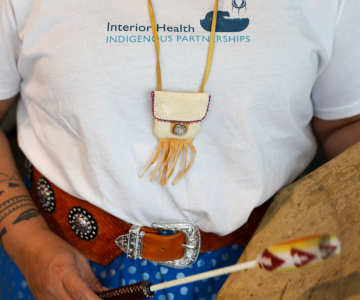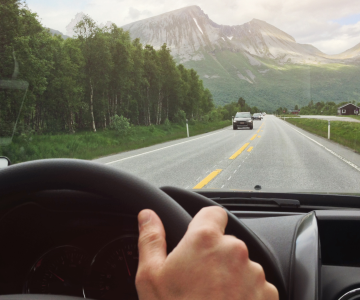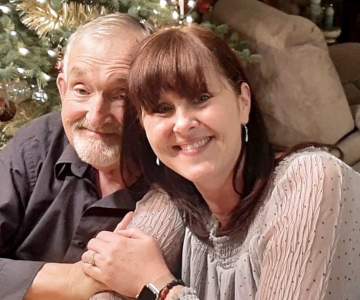Breadcrumb
Explore Stories
Health & Wellness
In the five years since the In Plain Sight (IPS) report was released, Interior Health (IH) has made strides toward being a culturally safe organization and improving the care it provides to Indigenous Peoples.
“I want to recognize both the progress achieved and emphasize the significant work that remains eliminating racism and increasing access and health outcomes working alongside Indigenous partners,” notes IH president & CEO Sylvia Weir.
Weir says, according to IH’s Indigenous partners, accounts of anti-Indigenous racism are increasing, and the organization is even more vigilant and steadfast about curbing all incidents of racism than ever.
“I want to be clear that any and all reports of racism at IH sites will be treated with the utmost seriousness,” she says. “I encourage reporting when this behaviour is encountered so that we can take action and apply our investigative and disciplinary powers to the fullest extent.”
This year’s IH response report includes interviews with Indigenous partners and Indigenous Patient Navigators to gain their valuable insights into how to best deliver services.
Community & Culture
Name: Angela Biddlecombe (she/her/hers) Job Title: Sterile Compounding Coordinator Length of Service: 20 years Worksite: East Kootenay Regional Hospital Pharmacy (sterile compounding satellite) Community: Cranbrook Ancestral Territory: Ktunaxa Favourite Quote / Advice to Live By: “I'm proud of my daughters' hard work and I enjoy seeing them develop into who they are. I love watching them skate—there's grace, strength and the ability to overcome pressure.”
Inspired by her aunt’s career as a pharmacist, Angela Biddlecombe joined the health-care sector more than two decades ago as a pharmacy technician, focusing on compounding, the preparation of custom medications.
Angela says pharmacy offers her a collaborative environment in which she thrives, a direct link to patient care, and the opportunity to mentor and support colleagues.
“I really enjoy the hands-on aspect of being a pharmacy technician and compounding products that are beneficial to patient care. I enjoy the problem solving to create new products, and the mentorship.”
Health & Wellness
This is part three in our three-part series that explores food literacy in schools in the Interior Health region.
The Souper Meals lunch program not only inspires students to try new foods and connect with each other over a meal but benefits our local food systems as well.
Across School District 83 and the Shuswap region, something simple is making a big difference at lunchtime: a warm bowl of soup.
Souper Meals is a school lunch program where soup, made with local produce and meats, is served along with fruit, veggies and buns to students once a week free of charge.
The program not only inspires students to try new foods and connect with peers over a shared meal, but it also invests in the local food system.
Community & Culture
With decades of experience rooted in compassion and commitment to children’s health, Dr. Jeff Wong is carving a strong path for pediatric care at Kelowna General Hospital (KGH) as the new head of the Pediatric Department.
In this new role, Dr. Wong is focused on rebuilding trust and creating a sustainable, collaborative system. “I see my role as a facilitator and coach,” he says. “We are building a system where all team members are actively engaged, involved and feel their voices are heard. People may come and go, but the system, if well-designed, lasts.”
His passion for pediatrics began early in his medical career. “I’ve always hoped to be a pediatrician since I first graduated,” he says.
In the early part of his career and after completing medical school at the University of Hong Kong, he rotated through several specialties as part of his internship. “My first rotation was pediatrics, and it was amazing. I realized I could help young patients—even those who couldn’t fully express themselves. I felt I was gifted in that way, so I decided to pursue pediatrics as my career.”
Taking a bold step, Dr. Wong applied exclusively to pediatric departments and secured a position in the Hong Kong Children’s Hospital. There, he built an impressive career, specializing in pediatric respirology and critical-care medicine, establishing a lung-function laboratory, and mentoring staff. A long-held plan to move to Canada would eventually redirect his path.
Dr Wong began his training over a decade ago in Canada as a clinical fellow at Stollery Children’s Hospital in Edmonton, including time in the Intensive care unit (ICU). “I really liked the culture and the people in Canada. My family and I always had a plan to come here,” he explains.
In 2021, he accepted a pediatric position at Penticton Regional Hospital, where he spent three years before joining the pediatric respirology team at Dalhousie University in Halifax. But the Okanagan’s unique balance of quiet and community life continued to call to him.
“My family really loves this region,” he says. Eventually, they returned to the British Columbia, where Dr. Wong initially provided locum respirology service at BC Children’s Hospital. It was during this time he was also picking up locum shifts at KGH and he became familiar with the local health care community. It helped shape his decision to become a full-time pediatrician at KGH.
Personal challenge
With his extensive experience, dedication and vision for a collaborative system, Dr. Wong is poised to lead Kelowna’s pediatric team toward a new chapter, one of reliability, excellence and renewed community trust.
His motivation for taking on the challenging leadership role at Kelowna General Hospital is deeply personal.
“I consider myself a member of the Okanagan region. My children live here, and I believe the kids here deserve excellent pediatric care. When I read about parents’ frustration during past service disruptions, it was heartbreaking. I wanted to step up and help create a system that allows our children—and their families—to receive consistent, high-quality care.”
To the community, Dr. Wong offers a heartfelt message: “I’m sorry for the previous service disruption. We are building a strong team, together with many experienced community pediatricians, committed to providing the best pediatric care possible. I understand that trust is easy to lose and hard to rebuild—but we are determined to regain it.”
Supporting each other is key, he explains. “Discussion between doctors and nursing staff often produces the best management plan for critically ill or complex patients.”
Dr. Wong took his new role in September of 2025.
Health & Wellness
With the holiday season here, many of us will be gathering to celebrate with family and friends. Celebrations often include food and sometimes alcohol.
While enjoying wine, beer and spirits can be a pleasurable part of holiday celebrations, drinking too much can have harmful consequences, both short and long-term.
Community & Culture
Name: Niomi Wright (she/her/hers)Job Title: Care AideLength of Service: 18 yearsWorksite: Mountain View LodgeCommunity: LillooetAncestral Territory: St’at’imc
Niomi Wright is a care aide at Mountain View Lodge located in Lillooet, B.C. on the traditional, ancestral and unceded territory of the St’at’imc Nation where she was born, raised and still lives.
After graduating high school, Niomi wasn’t sure what she wanted to do as a career. Initially, she thought she might pursue nursing. She decided to become a care aide first to get a feel for nursing to decide if it was the right long-term career choice.
Little did she know that she would ultimately discover that her true calling was to be a care aide in long-term care at Interior Health (IH).
Health & Wellness
The holidays are a time for celebration, connection and making memories—not collisions.
While many of us know the risks of drinking and driving, cannabis can also impair your ability to drive safely. One in four cannabis users admit to driving within four hours of consuming, even though THC, the main psychoactive compound in cannabis, can affect you for six hours or longer.
Health & Wellness
A new program is helping patients like Tim Goode, who spent eight long months at Kelowna General Hospital (KGH) after having a brain tumour removed in February.
Following the surgery, Tim made it home for only a day before returning to KGH by ambulance and being diagnosed with meningitis. This resulted in a few mini strokes, which caused weakness in his left side and required extensive rehab.
“I was right back in the hospital again for several weeks,” he notes.
The tumour at that point had also grown back, requiring yet another surgery.
He stayed at KGH until Nov. 15 when he was able to return to his acreage under the new Hospital at Home program.
“It’s an awesome program that we didn’t know anything about,” says Tim, who is now stable and on the road to recovery in the comfort of his own home.
“I’m doing pretty good. I’m mobile. I’ve got the use of my left hand back. Still a little bit weak on the left side, but good,” he says.
Community & Culture
Name: Naomi Jensen (she/her/hers)Job Title: Executive Director, Quality & Patient SafetyLength of Service: 29 yearsWorksite: RegionalCommunity: KamloopsAncestral Territory: SecwépemcFavourite Quote / Advice to Live By: What’s most important to me—in work and in life—is leading with kindness, integrity and purpose. I am always reminded that even small actions can create meaningful impact, and that how we show up for others truly matters.
Naomi Jensen, Executive Director, Quality & Patient Safety, lives in Kamloops on the traditional, ancestral and unceded territory of the Secwépemc Nation. Born and raised in 100 Mile House, Naomi began her career in health care during high school when she volunteered at the 100 Mile District Hospital.
As a volunteer, Naomi was paired with a nurse whose compassion, skill and presence left a lasting impression. “The way she truly connected with her patients—listening deeply, making them laugh and supporting them through some of their most difficult moments—showed me what exceptional care looks like,” shares Naomi.
It was in those early experiences that Naomi knew she wanted to be a nurse. For her, nursing has always been an honour and a privilege. She believes that people should be at the centre of their care, and that every interaction is an opportunity to make someone feel seen, respected and supported.
Over the years, Naomi’s been inspired not only by the patients and families served, but also by the incredible teams she’s had the privilege to work alongside.
-
Load More
Showing 9 of 817
Sign up for email updates
Receive news, alerts, public service announcements and articles right to your inbox.










